The Power of Values Statements
Core Values are deeply held convictions, priorities, and underlying assumptions that influence your organization’s attitudes and behaviors. They’re the enduring, passionate, and distinctive core beliefs that serve as your sounding board for how you’ll behave as a team. This article outlines a few simple ways you can begin to identify your core values.
Your core values and mission statement are part of your strategic foundation: the beliefs and purpose you and your team adhere to so you can achieve your vision of success.
Why Are Core Values Important?
Most commonly comprised of 4-7 smaller, concise statements, core values become the guiding principles for how people in an organization are expected to behave, how teams treat each other, and how you expect your organization to treat your customers.
These statements are to be embedded in your every day, from daily actions to long-term strategic focus.
A strategic plan is not complete without a declaration of the underlying beliefs in your organization. These core values need to guide your team as you develop your strategic plan, informing what strategic choices you will [or will not] make to stand with your values.
Get the Free Guide to Identify and Live Your Core Values
Core Values Answer These Questions
- What key non-negotiables are critical to the success of the company?
- What guiding principles are core to how we operate in this organization?
- What behaviors do you expect to see from the team?
- Are you willing to stand by these values no matter what the cost—for example, lost clients or lost revenue?
Anatomy of a Core Values Statement
As a refresher from our what are core values statements, here is how a values statement is intended to be structured and written. This can be example and the free cheat sheet on developing your core values can be helpful to reference as you work with your team to identify your core values.
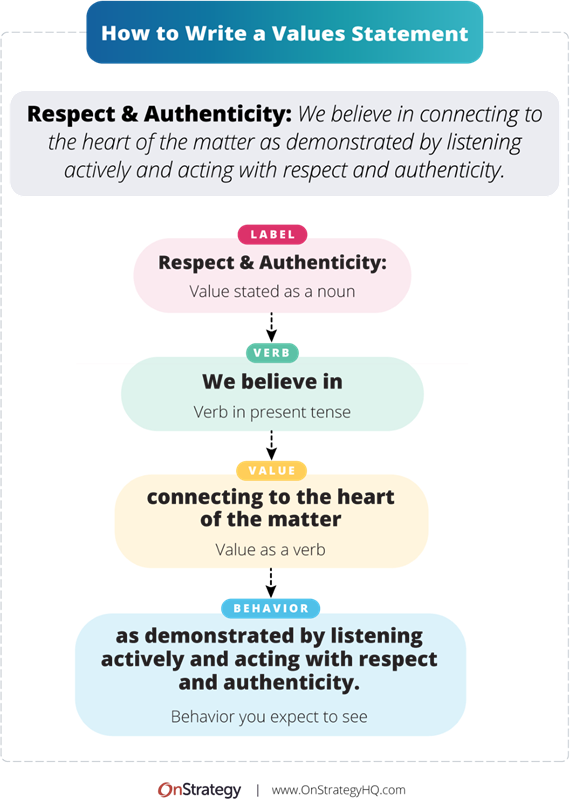
Non-Profit Core Values
If you’re a non-profit, before starting this exercise, we also recommend looking at Prosper Strategies’ examples of non-profit values. It’s really helpful to reference in addition to the exercise below!
How to Identify Your Core Values
Since values reflect the beliefs and behaviors of your team and organization, it’s not an exercise we recommend completing alone.
Your values need to reflect your entire organization; we recommend completing this exercise with your broader team to reflect what your organization values holistically.
Materials Needed
- Small Sticky Notes – 3 to 5 Per Person
- A White Board or blank wall. Alternatively, you can use a whiteboard tool like Miro or Mural if you want to do this exercise virtually.
Step 1: Set Up the Whiteboard
Setting up this whiteboard is simple. The easiest way is to draw ten vertical columns across the board. As you complete this exercise, either virtually or with your team, you will use these columns as theme areas.
We also recommend adding these three core questions to the top of your whiteboard facilitation as prompts for your team to consider during the exercise:
- What key non-negotiables are critical to the success of the company?
- What guiding principles are core to how we operate in this organization?
- What behaviors do you expect to see from our team?
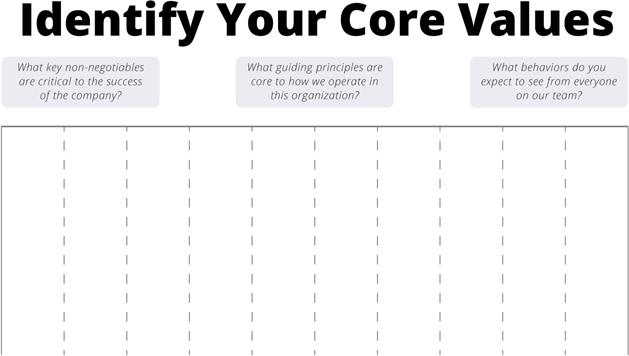
Pro Tip:
We like adding these prompts above the exercise as guideposts for thinking. You’ll ask your team specific questions in step two, but these are still nice to consider as you complete the exercise.
Step 2: Have Each Team Member Identify Your Core Values
Core values are not created in an organization but instead identified from your team’s current behavior. Which is why you need your team to help identify your core values! The best core values articulate behavior your team already exhibits, which are essential to your success —so important they warrant being core values.
Provide each person in the room with 3 to 5 small sticky notes. Choose ONE of the following questions. Then, ask everyone to write down their answers (one value per sticky note):
- Identify up to 5 behaviors you see every day that are key to your success with your customers, with your team, and as an employer. e.g., Approachable: ask for feedback and be open to suggestions.
- If you were hiring for a position on your team, what character traits would a candidate need to demonstrate to be a good fit for the organization? e.g., Detail oriented: know that details make the difference.
Pro Tip:
Identify current values, don’t create aspirational values. Your values statements should reflect current behaviors you consistently see and are critical to your culture.
Step 3: Present and Organize
Ask one person to report out first by placing the sticky notes horizontally on the whiteboard or wall.
Ask each person in the room to add their values under an idea that is already on the wall. If a new value or theme is created, add a new column. As you discuss and add sticky notes, it should begin to look like this:
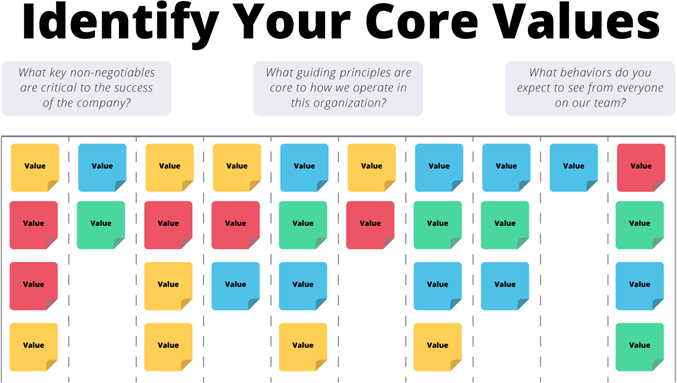
Step 4: Choose Values Based on Themes
Based on the values that have the most sticky notes, choose those as the core values of the organization. From your board, it will be easy to see which values are mentioned the most.
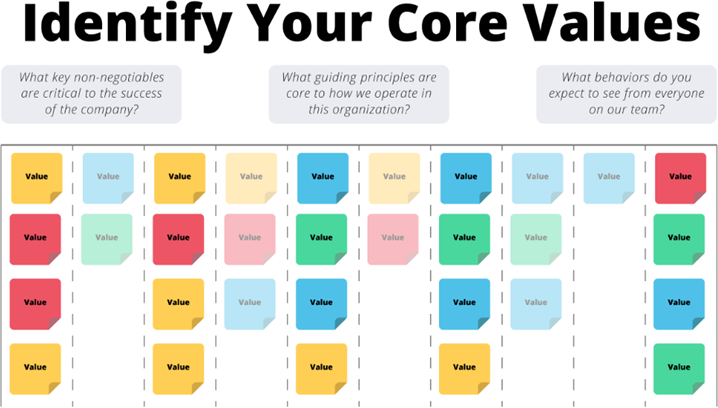
Step 5: Discussion on Themes
For each value, quickly discuss “how we behave when we are living the value.” Capture this information on the whiteboard.
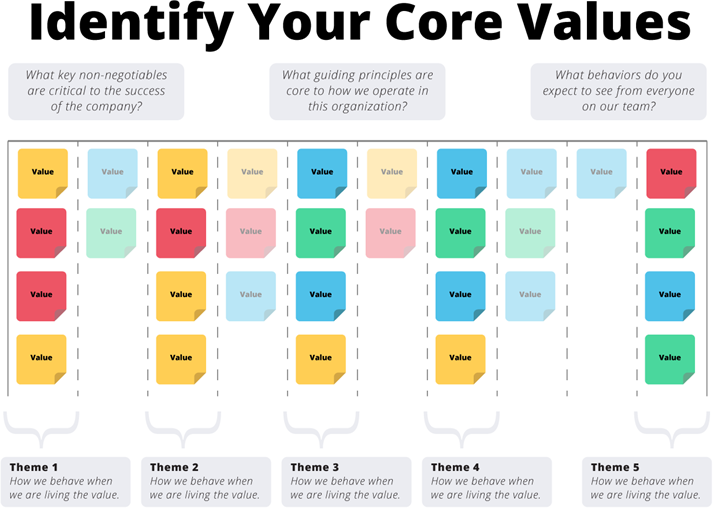
Pro Tip:
If it’s a one-word value, e.g. “Approachable,” describe what behavior your team expects to see when that value is in play. An example behavior of being approachable might include: asking for feedback and always keeping our minds open to suggestions.
Step 6: Draft Your Values
Assign someone to draft the values statements similar to that of the Zappos structure: core value theme and 1 or 2 sentences explaining the behaviors.
Pro Tip:
Take the writing offline. Spending time wordsmithing as a group is not a good use of your time.
Evaluation: Did You Get It Right?
- Are these non-negotiables in how you operate?
- Do these values clearly express how you expect your team to behave to be successful?
Fixing the cta placement












